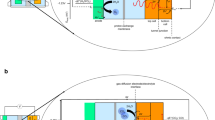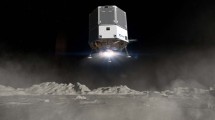Introduction
Energy is fundamental to nearly everything that humans would like to do in space, whether it is science, commercial development, or human exploration. If indigenous energy sources can be developed, a wide range of possibilities emerges for subsequent development. Some of these will lower the cost of future exploration, others will expand the range of activities that can be carried out, and some will reduce the risks of further exploration and development. This picture is particularly true for the Moon where significant electrical energy will be required for a number of lunar development scenarios; including science stations, lunar resource processing, and tourism. As example, the presence of water in the permanently shadowed craters at the poles of the Moon (Colparete et al. 2010; Heldman et al. 2011) will allow for propellant production: oxygen and hydrogen through electrolysis which will require significant amounts of electrical energy. Further, proposed large radio telescopes on the back side of the Moon would require over 1 MW of power for echo microwave astronomy. The availability of solar cell raw materials in the surface regolith of the Moon, e.g., silicon, and the fact that the surface of the Moon is an ultra-high vacuum (1 x 10− 10 Torr) environment allows for the direct fabrication of thin film solar cells directly on the surface of the Moon.
Access this chapter
Tax calculation will be finalised at checkout
Purchases are for personal use only
Preview
Unable to display preview. Download preview PDF.
Similar content being viewed by others
References
Briggs, R.A., Sacco Jr., A.: Hydrogen reduction mechanism of ilmenite between 823 and 1353 K. J. Mater. Res. 6(3), 574–584 (1990)
Burt, D.M.: Lunar Mining of Oxygen Using Fluorine. Amer. Sci. 77, 574–579 (1989)
Colaprete, A., Schultz, P., Heldmann, J., Wooden, D., Shirley, M., Ennico, K., Hermalyn, B., Marshall, W., Ricco, A., Elphic, R.C., Goldstein, D., Summy, D., Bart, G.D., Asphaug, E., Korycansky, D., Landis, D., Sollitt, L.: Detection of Water in the LCROSS Ejecta Plume. Science 22, 463–468 (2010)
Eagle Engineering, Conceptual Design of a Luna Oxygen Pilot Plant Lunar Base Study, NASA-JSC NAS9-17878, Task 4.2(1988)
Filsinger, D.H., Bourrie, D.B.: Silica to Silicon: Key Carbothermic Reactions and Kinetics. J. Am. Ceram. Soc. 73(6), 1726–1732 (1990)
Heldman, J., et al.: LCROSS (Lunar Crater Observation and Sensing Satellite) Observation Campaign: Strategies, Implementation, and Lessons Learned, Space Science Reviews (2011), doi:10.1007/s11214-011-9759-y
Ignatiev, A., Kubricht, T., Freundlich, A.: Solar Cell Development on the Surface of the Moon. In: Proc. 49th International Astronautical Congress, IAA-98-IAA. 13.2.03 (1998)
Ignatiev, A., Freundlich, A.: Lunar Regolith Thin Films: Vacuum Evaporation and Properties. In: AIP Proceedings, vol. 420, p. 660 (1998)
Keller, R.: Lunar Production of Aluminum, Silicon and Oxygen. In: Sohn, H.Y., Geskin, E.S. (eds.) Metallurgical Process for the Year 2000 and Beyond, pp. 551–562. Mineral, Metal and Materials Soc., Warrendale, PA (1988)
Knudsen, C., Gibson, M.: Development of the Carbotek ProcessTM for Lunar Oxygen Production. Engineering, Construction and Operations in Space II, American Society of Civil Engineers, p. 357 (1990)
Lin, H.Y., Chen, Y.W., Li, C.: The mechanism of reduction of iron oxide by hydrogen. Thermochimica Acta 400, 61–67 (2003)
Nakamura, T., Van Pelt, A.D., Smith, B.K.: Solar Thermal System for Oxygen Production from Lunar Regolith. In: 47th AIAA Aerospace Sciences Meeting, AIAA-2009-0660, Orlando, January 5-8 (2009)
Rao, D.B.: Extraction Processes for the Production of Aluminum, Titanium, Iron, Magnesium and Oxygen from Non-terrestrial Sources. Space Resources and Space Settlements, NASA SP-428 (1979)
Rosenberg, S.D., Guter, G.A., Miller, F.R.: The On-Site manufacture of Propellant Oxygen Utilizing Lunar Resources. Chem. Engr. Prog. 62, 228 (1964)
Rosenberg, S.D., Hermes, P., Rice, E.E.: Carbothermal Reduction of Lunar Materials for Oxygen Production on the Moon. Final Report, In Space Propulsion, Ltd., Contract NAS 9-19080 (1996)
SBIR Final Report, Lunar In-Situ Fabrication: The Manufacturing of Thin Film Solar Cells on the Surface of the Moon. NASA #NNM04AA65C (2006)
Author information
Authors and Affiliations
Editor information
Editors and Affiliations
Rights and permissions
Copyright information
© 2012 Springer-Verlag GmbH Berlin Heidelberg
About this chapter
Cite this chapter
Ignatiev, A., Freundlich, A. (2012). The Use of Lunar Resources for Energy Generation on the Moon. In: Badescu, V. (eds) Moon. Springer, Berlin, Heidelberg. https://doi.org/10.1007/978-3-642-27969-0_13
Download citation
DOI: https://doi.org/10.1007/978-3-642-27969-0_13
Publisher Name: Springer, Berlin, Heidelberg
Print ISBN: 978-3-642-27968-3
Online ISBN: 978-3-642-27969-0
eBook Packages: EngineeringEngineering (R0)




